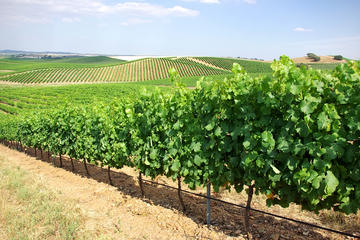Alentejo
TIME : 2016/2/22 13:50:28

Alentejo
Stretching from the Spanish border to the Atlantic coast and touching on the Algarve to the south, the scenic Alentejo uplands are fast becoming one of Portugal’s premier wine-producing areas. At the heart of the Alentejo – which roughly translates as ‘beyond the Tagus’ – lies Évora, the ancient capital of the region.
UNESCO World Heritage-listed Évora is an enticing city with its long history laid bare for all visitors to see. Nine miles (14.5 km) west is the Cromeleque dos Almendres, a series of prehistoric standing stones, while in the city center there are 2,000 year-old ruins of a Roman temple, the macabre Capela dos Ossos ossuary, and a splendid Gothic cathedral to explore around the photogenic Praça do Giraldo. On summer evenings, tables are crowded into the square and side-street bars and boutiques are open until the wee hours.
The Alentejo plains themselves enjoy reliably dry, sunny summers and cool winters, perfect for growing grapes. The region is quickly acquiring a reputation for producing full-bodied DOC red wines as well as less expensive but still very drinkable VR table wines, which feature on many a wine list in Lisbon. Although the Alentejo is currently going through a renaissance in its wine production, largely thanks to the introduction of French grapes to the mix in the 1990s, wine has actually been produced here since Roman times, along with the cork and olives that form a massive part of Portugal’s economy.
There are three way-marked driving routes that wind across the sleepy plains of the Alentejo past the wineries, cork and olive plantations, where serried ranks of neatly cultivated trees and bushes march across the landscape towards the horizon. Several prestigious wine-growing adegas are open daily along the wine route for tours and tastings of their wines and olive oils.
Practical Info
Évora is at the heart of the Alentejo region and is an easy 90-minute drive south-east of Lisbon, leaving the city by the dramatic 25th April Bridge – Europe’s longest suspension bridge – over the River Tagus. Most of Évora’s attractions are open throughout the year and the Cromeleque dos Almendres free to visit. Wine tastings should be booked in advance unless travelling with a guided tour.
